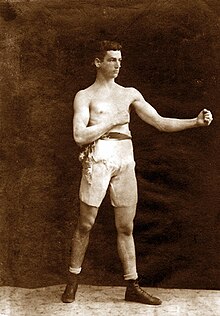Kid McCoy
| Charles "Kid" McCoy | |
|---|---|

McCoy in 1899
|
|
| Statistics | |
| Real name | Norman Selby |
| Rated at | Middleweight |
| Height | 5 ft 11 in (1.80 m) |
| Nationality | American |
| Born |
October 13, 1872 Moscow, Indiana, U.S. |
| Died | April 18, 1940 (aged 67) Detroit, Michigan, U.S. |
| Boxing record | |
| Wins | 81 |
| Wins by KO | 55 |
| Losses | 6 |
| Draws | 9 |
Charles "Kid" McCoy (October 13, 1872 – April 18, 1940), born Norman Selby, was an American world champion boxer.
Born in Moscow, Rush County, Indiana, McCoy would eventually weigh 160 pounds, stand 5' 11", and go on to a record 81 wins (55 by KO, with 6 losses, 9 no decision, and 6 disqualifications). McCoy was noted for his "corkscrew punch"–a blow delivered with a twisting of the wrist. According to McCoy, he learned the punch one evening while resting in someone's barn after a day of riding the rails. He noticed a cat strike at a ball of string and imitated its actions. Whether true or not, McCoy was known as a fast, "scientific" fighter who would cut his opponents with sharp blows. He reportedly would wrap his knuckles in mounds of friction tape, to better cut his opponents faces. He was listed # 1 Light Heavyweight of all time in Fifty Years At Ringside, published in 1958. He was also regarded as a formidable puncher, and was included in Ring Magazine's list of 100 greatest punchers of all time.
Another one of McCoy's tactics was demonstrated while McCoy was on a tour of Australia and some Pacific Isles. To supplement his income, he would take on all comers. In one unidentified port, McCoy, who scarcely weighed 160 pounds (73 kg), agreed to box a huge native reputed to weigh in excess of 250 pounds (110 kg). McCoy watched him train and noted the man fought in his bare feet. When the fight began, McCoy's corner threw handfuls of tacks into the ring, causing the bare-footed challenger to drop his guard and raise up one foot. As soon as he did so, McCoy lowered the boom on his distracted adversary.
It was thought that the expression "The Real McCoy" originally referred to him. With regard to this, once again, stories abound. One scenario involves a local tough who bumped into McCoy in a bar. McCoy, who was slight of build and a dapper dresser, did not look like a fighter. The bar room bully reputedly laughed when told the slender fellow he was annoying was Kid McCoy. He then challenged McCoy to fight, and upon reviving from being knocked out allegedly remarked "Oh my God, that was the real McCoy". However, it is believed that the first recording with this spelling occurred in Canada in 1881. In James S. Bond's The Rise and Fall of the "Union club": or, Boy life in Canada, a character utters, "By jingo! yes; so it will be It's the 'real McCoy,' as Jim Hicks says. Nobody but a devil can find us there." Kid McCoy was only nine years old when this was published.
...
Wikipedia
